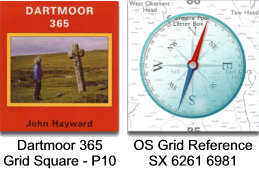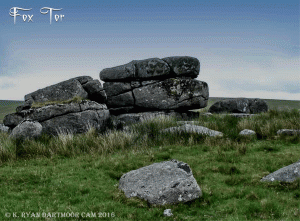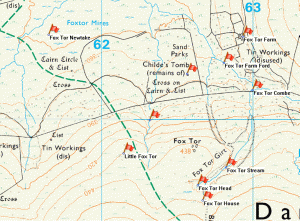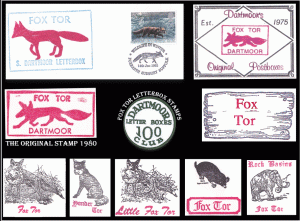
“Ascending the northern slope, we look around. Not a cheerful view certainly. A little moorland farm, whence a dog issues barking furiously at the presence of a strange human form, is the only human habitation in sight. On the side of the hill commanding the valley beneath, rise the low piles of Fox Tor, overlooking the famous or infamous, ‘Mire‘.”, Page, p.154.
“The Swincombe river sang on her way to the Dart; Fox Tor’s turrets, touched with rose, ascended southward, and beyond looming darkly against the south appeared the bosom of Caters Beam.“, Phillpotts, p.33.
There can be no question that Fox Tor stands sentinel above many of Dartmoor’s famous landscape features such as; Fox Tor Mires, Childe’s Tomb, the Prehistoric kist known as Grandpa’s Grave and the ruins of the old Fox Tor farm. In many ways all these features over-shadow the tor due to either their notoriety or historical interest. To see just how much simply put in a Google search for ‘Fox Tor’ and most of what’s returned will relate to the mire, Childe’s Tomb or the Fox Tor cafe. So here is a page to slightly redress the balance.
There can be no question that over time the tor has witnessed man’s various attempts to wrest a profit from the moor. The tinners in search of the precious ore in and around it’s piles and at Whiteworks and the agricultural improvers at the farm. If folklore is to believed it saw the unfortunate Childe the Hunter frozen to death inside his horse’s carcass. It certainly will have witnessed prehistoric man performing their burial rituals in the granite tombs which lay below. And speaking as one who has experienced it the tor will have watched many a traveller and walker floundering across the quaking mire below who has stolen the tor’s name – Foxtor Mires.
But what about the poor, neglected tor itself? The first recorded semblance of the place-name can be found in a document of 1444 where the name Foxtorre Combe appeared, Gover et. al. p.198. The Place-Name Society give no interpretation of the name but the ‘combe’ element is obvious as is the’ tor’ suffix but one may only assume that the ‘fox’ prefix alludes to somewhere frequented by foxes? As can be seen from the map below there are numerous landscape features that take the name of Fox Tor, these being a; Combe, Farm, Farm Ford, Gert, Gulf, Head, House, Mires, Newtake and Stream. In addition there is a smaller outcrop to the west of the main tor known as ‘Little Fox Tor’, this is sometimes referred to as ‘Yonder Tor’. Although once again overshadowed by Fox Tor Farm, the tor and it’s ‘turrets’ do feature in Eden Phillpott’ novel – The American Prisoner and in 1929 an early movie was shot on location at the tor.
Fox tor sits at an altitude of 438 metres and consists of three piles of granite and is skirted by large clitter fields of rocks, it from here where the stones were taken to build what seems to be the endless walls of Fox Tor newtake and more than likely the farm as well. Although now long gone the tor was once the breeding grounds for the Dartmoor raven who according to William Crossing could often be seen on hot summer days, p.95. One thing that the tor is quite famous for is the ‘Mammouth’s Skull’ which I think may have been the invention of Eric Hemery. In his ‘High Dartmoor’ book he explains that on the southern pile is; “an object of great interest in the fallen summit-rock that bears on its surface two large basins like eye-sockets in the skull of a mammouth greater than prehistory ever knew.”, p.336. Starkey also mentions what he calls the ‘Bony Skull’; “At Fox Tor there is another granite mass containing rock basins which has slipped from the horizontal to the nearly perpendicular position. In this case, seen from a distance, the basins appear as eye sockets in some great bony skull, a trifle startling when first seen looming through the mist.”, p.74. It goes without saying that there are thousands of granite formations on the moor and it doesn’t take much to imagine them taking on a plethora of likenesses. Amongst the more famous Rock Idols‘ are of course the Mammouth’s Skull, the ‘Camel’, the ‘Fish’ and the ‘Neanderthal’ to name but a few.
Another claim to fame for Fox Tor was that it was the location for one of the early letterboxes which was sited way back in 1975. Ever since then it has been a popular place for siting letterboxes of various kinds. As you can see below there’s no prizes fro guessing what the subject of many of the letterboxes are – the fox. Whilst on the subject of Fox Tor and letterboxing there is something else that springs to mind. I can remember one letterbox which was sited just below the tor in a pile of tinner’s rubble which was really a challenge, not to find but to pluck up the courage to get it. The small crevice in which it was hidden in sat above an adder’s nest and one just hoped the occupants weren’t at home when you put your hand in to get it.
I must admit that when one stands at Whiteworks Fox Tor seems relatively close, in fact it’s only 1.8 kilometres away but that means crossing the quaking mire. Should this prospect seem somewhat daunting then the route which ensures dry boots is longer at around 3.2 kilometres.


Crossing, W. 1966. Crossing’s Dartmoor Worker. Newton Abbot: David & Charles.
Gover, J. E. B., Mawer, A. & Stenton, F. M. 1992. The Place-Names of Devon. Nottingham: The Place-Name Society.
Hemery, E. 1983. High Dartmoor. London: Robert Hale.
Page, J. Ll. W. 1895. An Exploration of Dartmoor. London: Seeley & Co. Ltd.
Phillpotts, E. 1904. The American Prisoner. Toronto: George N. Morang & Co. Ltd.
Starkey, F. H. 1984. Odds and Ends from Dartmoor. F. H. Starkey.
 Legendary Dartmoor The many aspects past and present of Dartmoor
Legendary Dartmoor The many aspects past and present of Dartmoor



